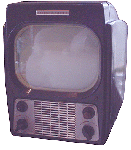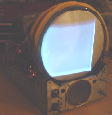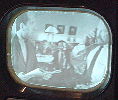General Electric 805 TV Restoration Project


When I first disassembled the television by removing the two front screws and the four bottom screws, I immediately knew this television had been repaired quite often in the past. The second half of the high voltage cage was missing, and the deflection yoke was replaced and obviously does not fit properly. Also the 10" CRT itself does not seem original. Below is a picture of the innards when I first took the chassis out of the case.

Many of the video amplifier tubes were weak so I replaced most of them with what I had in hand, but nothing was quite good enough to get a picture or snow on the screen. At this point, recapping the entire television was the only necessary option left so I spent several days replacing over 20 capacitors and restuffing those that were visible on the chassis by pushing out the old innards out of the paper body and fitting a new one in place. Finally, some snow came in on several stations, but there was still no picture.
I fiddled with the controls for quite some time until I realized there was a picture, but the horizontal frequency was way off. I noticed a new variable coil in the rear for the horizontal frequency, which I had to adjust a LOT; I must have rotated the adjustable screw more than 15 times to get the frequency right. Finally a weak picture came in, but rather than the traditional vertical picture flip, the horizontal was flipping badly. I found out that the sync separator tube was acting a bit odd so I replaced it and most of the other tubes in the horizontal and vertical stages. After tweaking with most of the controls, the picture became stable.
Unfortunately, the picture was still shifted to the left and the vertical size was insufficent to fill the face correctly. One possibility was insufficent high voltage from the flyback, but the picture was quite bright, the B+ voltage was just right, and there was a nice arc from the flyback to a well-insulated screwdriver so this was not the problem. Obviously the deflection yoke was useless. I found someone who had a GE 805 parts chassis, and was kind enough to sell the original deflection yoke for a good price. I replaced the entire yoke and the focus coil was repositioned. The picture problem was immediately resolved after a few control adjustments. Below is a picture of a show with a clear, crisp picture.
